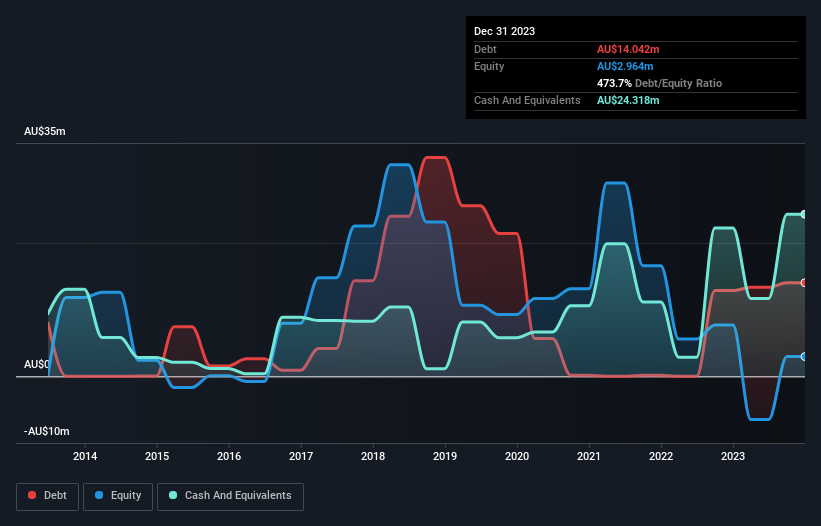Legendary fund manager Li Lu (who Charlie Munger backed) once said, 'The biggest investment risk is not the volatility of prices, but whether you will suffer a permanent loss of capital.' It's only natural to consider a company's balance sheet when you examine how risky it is, since debt is often involved when a business collapses. We note that Northern Minerals Limited (ASX:NTU) does have debt on its balance sheet. But the real question is whether this debt is making the company risky.
Why Does Debt Bring Risk?
Debt is a tool to help businesses grow, but if a business is incapable of paying off its lenders, then it exists at their mercy. In the worst case scenario, a company can go bankrupt if it cannot pay its creditors. However, a more frequent (but still costly) occurrence is where a company must issue shares at bargain-basement prices, permanently diluting shareholders, just to shore up its balance sheet. Of course, plenty of companies use debt to fund growth, without any negative consequences. The first step when considering a company's debt levels is to consider its cash and debt together.
See our latest analysis for Northern Minerals
What Is Northern Minerals's Debt?
You can click the graphic below for the historical numbers, but it shows that as of December 2023 Northern Minerals had AU$14.0m of debt, an increase on AU$12.9m, over one year. But it also has AU$24.3m in cash to offset that, meaning it has AU$10.3m net cash.

A Look At Northern Minerals' Liabilities
According to the last reported balance sheet, Northern Minerals had liabilities of AU$23.1m due within 12 months, and liabilities of AU$5.43m due beyond 12 months. Offsetting these obligations, it had cash of AU$24.3m as well as receivables valued at AU$653.3k due within 12 months. So its liabilities total AU$3.56m more than the combination of its cash and short-term receivables.
This state of affairs indicates that Northern Minerals' balance sheet looks quite solid, as its total liabilities are just about equal to its liquid assets. So while it's hard to imagine that the AU$224.8m company is struggling for cash, we still think it's worth monitoring its balance sheet. While it does have liabilities worth noting, Northern Minerals also has more cash than debt, so we're pretty confident it can manage its debt safely. There's no doubt that we learn most about debt from the balance sheet. But you can't view debt in total isolation; since Northern Minerals will need earnings to service that debt. So when considering debt, it's definitely worth looking at the earnings trend. Click here for an interactive snapshot.
Since Northern Minerals has no significant operating revenue, shareholders probably hope it will develop a valuable new mine before too long.
So How Risky Is Northern Minerals?
We have no doubt that loss making companies are, in general, riskier than profitable ones. And we do note that Northern Minerals had an earnings before interest and tax (EBIT) loss, over the last year. And over the same period it saw negative free cash outflow of AU$21m and booked a AU$29m accounting loss. But at least it has AU$10.3m on the balance sheet to spend on growth, near-term. Summing up, we're a little skeptical of this one, as it seems fairly risky in the absence of free cashflow. The balance sheet is clearly the area to focus on when you are analysing debt. But ultimately, every company can contain risks that exist outside of the balance sheet. For instance, we've identified 2 warning signs for Northern Minerals (1 shouldn't be ignored) you should be aware of.
Of course, if you're the type of investor who prefers buying stocks without the burden of debt, then don't hesitate to discover our exclusive list of net cash growth stocks, today.
Valuation is complex, but we're here to simplify it.
Discover if Northern Minerals might be undervalued or overvalued with our detailed analysis, featuring fair value estimates, potential risks, dividends, insider trades, and its financial condition.
Access Free AnalysisHave feedback on this article? Concerned about the content? Get in touch with us directly. Alternatively, email editorial-team (at) simplywallst.com.
This article by Simply Wall St is general in nature. We provide commentary based on historical data and analyst forecasts only using an unbiased methodology and our articles are not intended to be financial advice. It does not constitute a recommendation to buy or sell any stock, and does not take account of your objectives, or your financial situation. We aim to bring you long-term focused analysis driven by fundamental data. Note that our analysis may not factor in the latest price-sensitive company announcements or qualitative material. Simply Wall St has no position in any stocks mentioned.
About ASX:NTU
Northern Minerals
Operates in the mineral exploration industry in Australia.
Excellent balance sheet with moderate risk.
Similar Companies
Market Insights
Community Narratives



